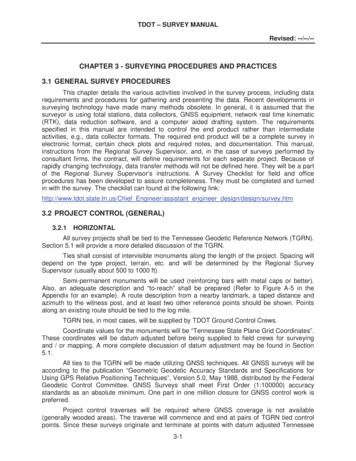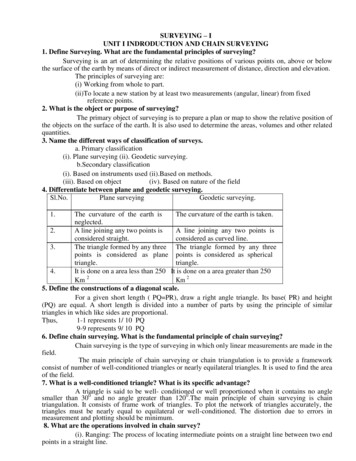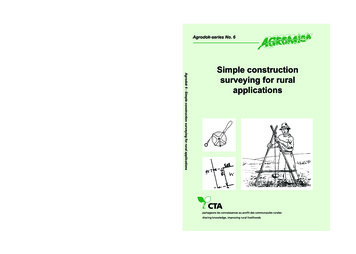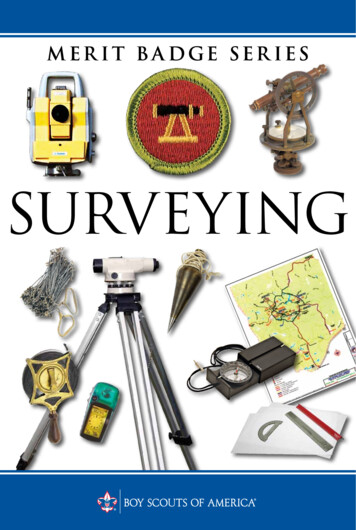
Transcription
TDOT – SURVEY MANUALRevised: --/--/--CHAPTER 3 - SURVEYING PROCEDURES AND PRACTICES3.1 GENERAL SURVEY PROCEDURESThis chapter details the various activities involved in the survey process, including datarequirements and procedures for gathering and presenting the data. Recent developments insurveying technology have made many methods obsolete. In general, it is assumed that thesurveyor is using total stations, data collectors, GNSS equipment, network real time kinematic(RTK), data reduction software, and a computer aided drafting system. The requirementsspecified in this manual are intended to control the end product rather than intermediateactivities, e.g., data collector formats. The required end product will be a complete survey inelectronic format, certain check plots and required notes, and documentation. This manual,instructions from the Regional Survey Supervisor, and, in the case of surveys performed byconsultant firms, the contract, will define requirements for each separate project. Because ofrapidly changing technology, data transfer methods will not be defined here. They will be a partof the Regional Survey Supervisor’s instructions. A Survey Checklist for field and officeprocedures has been developed to assure completeness. They must be completed and turnedin with the survey. The checklist can found at the following link:http://www.tdot.state.tn.us/Chief Engineer/assistant engineer design/design/survey.htm3.2 PROJECT CONTROL (GENERAL)3.2.1HORIZONTALAll survey projects shall be tied to the Tennessee Geodetic Reference Network (TGRN).Section 5.1 will provide a more detailed discussion of the TGRN.Ties shall consist of intervisible monuments along the length of the project. Spacing willdepend on the type project, terrain, etc. and will be determined by the Regional SurveySupervisor (usually about 500 to 1000 ft).Semi-permanent monuments will be used (reinforcing bars with metal caps or better).Also, an adequate description and “to-reach” shall be prepared (Refer to Figure A-5 in theAppendix for an example). A route description from a nearby landmark, a taped distance andazimuth to the witness post, and at least two other reference points should be shown. Pointsalong an existing route should be tied to the log mile.TGRN ties, in most cases, will be supplied by TDOT Ground Control Crews.Coordinate values for the monuments will be “Tennessee State Plane Grid Coordinates”.These coordinates will be datum adjusted before being supplied to field crews for surveyingand / or mapping. A more complete discussion of datum adjustment may be found in Section5.1.All ties to the TGRN will be made utilizing GNSS techniques. All GNSS surveys will beaccording to the publication “Geometric Geodetic Accuracy Standards and Specifications forUsing GPS Relative Positioning Techniques”, Version 5.0, May 1988, distributed by the FederalGeodetic Control Committee. GNSS Surveys shall meet First Order (1:100000) accuracystandards as an absolute minimum. One part in one million closure for GNSS control work ispreferred.Project control traverses will be required where GNSS coverage is not available(generally wooded areas). The traverse will commence and end at pairs of TGRN tied controlpoints. Since these surveys originate and terminate at points with datum adjusted Tennessee3-1
TDOT – SURVEY MANUALRevised: --/--/-State Plane Coordinates, all computed coordinates will be datum adjusted Tennessee StatePlane Coordinates. No further datum adjustment is required.Project control traverses shall meet Second Order Class II Standards (1:20000) orbetter, (Refer to Section 5.2 and Appendix Tables A-4 and A-5).After the raw field data for project control has been compiled, computed, and minimumstandards met, traverses shall be adjusted using the least squares method.Each leg of the project control survey (between adjacent pairs of TGRN tie points) shallbe considered and adjusted independently.All TGRN tie points (control pairs) and project control traverse points shall be clearlyshown and labeled in the planimetrics file (Refer to Section 3.4.2).Coordinates will be listed with current notation plus the year of the upgrade inparentheses, immediately following. Therefore, reference to current coordinate values will beNAD 83 (1995) for geographic coordinates and SPCS 83 (1995) for state plane coordinates.3.2.2VERTICALGNSS methods may be used for vertical control for projects provided approvedprocedures are followed.Please check with the TDOT Regional Survey Supervisor for a recommendation as tothe appropriate geoid model to utilize. Known third order or better North American VerticalDatum of 1988 (NAVD 88) benchmarks are occupied in the project control sessions and usedfor vertical ties and adjustment.TDOT ground control crews will normally provide vertical control.3.3 PROJECT CONTROL (GNSS PROCEDURES)3.3.1PRE-PLANNINGAssemble TVA / United States Geological Survey (USGS) quad maps, theTransportation Planning Report (TPR), photos, etc. for the project. Locate the project on thequad map and read the approximate latitude and longitude of the project.Based upon the map, the surveyor can get a rough idea of the number of points that willbe required, and how long it might take to establish control for the project. Estimate pointplacement, manpower needs, and potential problems with satellite blockage from this map also.The surveyor can also get an idea of how much of the project will be accessible by vehicle andwhere walking to the point will be required.Check satellite predictions based upon satellite almanacs. Use this information to planoccupation times.3.3.2RECONNAISSANCEContact any property owners in accordance with requirements in Chapter 1.Determine control point placement as follows: Place points in the clear, away from trees, buildings and potential multi-pathstructures. Maximum obstruction angle shall be 20º.Nominal control point spacing of 500 ft to 1000 ft.3-2
TDOT – SURVEY MANUALRevised: --/--/- 3.3.3Points should be intervisible when possible. Exceptions will be large wooded areas.Note the example in Appendix Figure A-26 shows a wooded area. The surveyorwould simply skip this area and start placing points again on the other side.Place points close to the projected centerline so that they will be of the most use tothe surveyors (i.e. on hilltops). However, some thought should also be given toplacing these points so that at least some of them will survive construction.Document blockage problems on the site log. A site log form is shown in AppendixFigure A-24. If there are blockage problems, place the control point to the south ofthe blockage since the satellite path never crosses due north.RECEIVER SETUP PROCEDURES3.3.3.1 STATIC METHOD Improper instrument setup (human error) accounts for the most and the largesterrors when performing GNSS surveys. Therefore, care must be exercised duringsetup. Use extra care to assure correct set up on the point. Make sure to properly focus the plummet and cross-hairs. Check to assure theinstrument is on the point during the session and before breaking down the tripod tomove. Triple checking the setup will greatly reduce the human error during thesession. Check and record the height of instrument (HI) reading on the site log when settingup. Check the HI again during the recording session and once more before breakingdown the instrument to move. This again aids in reducing human error during thesession. Set the tripod so that the receiver is at or above head height. Set the tripod legs wide enough to prevent the tripod from being blown over. Press the tripod feet firmly into the ground. If sent to retrieve another receiver, check the setup before breaking it down. Do not be afraid to report possible errors to the party chief. It is better to reoccupythe point while the survey crew is still in the field, than to try and determine whatwent wrong back in the office.3.3.3.2 RTK METHOD WITH A BASE STATION TDOT control points should be located on the job and the base should be setup onone of the control points (preferably one that has the best visibility of the sky and islocated in a relatively safe place). The surveyor should try to prevent the base from being disturbed or being anobstruction to traffic. The surveyor should use a fixed tripod to set the base on, as this is the most stable.3.3.4OBSERVATION METHODSThe three methods of observations are discussed below: Static TraverseStatic Wing PointRTK3-3
TDOT – SURVEY MANUALRevised: --/--/-3.3.4.1 STATIC METHODSThere are two basic methods used by TDOT using static GNSS procedures to bringcontrol into a project from the TGRN reference points. For this discussion, we will refer to themas the Traverse Method and the Wing Point Method. Table 3-1 shows advantages anddisadvantages of each method.A diagram of both methods is shown in Appendix Figures A-25, A-26, and A-27.Traverse MethodWing Point MethodAdvantagesUses similar leapfrog methodology asthe conventional traverse. Is moreefficient for projects with five or fewercontrol points.Baselines are longer, minimizing error.Points are measured from two basepoints giving a check. Wing points arelikely to survive construction for lateruse. Less coordination is requiredbetween receiver operators. Basestations require little supervision forinexperienced operators. A truenetwork is formed, giving strongerchecks and adjustments. Wing pointscan be existing NGS benchmarksgiving a vertical check on the network.DisadvantagesDue to inherent possibleerrors in GNSS baselines,error can accumulate rapidly.Requires high degree ofcoordination between surveycrew. Requires higher degreeof sophistication from all crewmembers.Time and effort are required tolocate and set the wing points.Wing points are only useful forGNSS work because theyhave no Azimuth points.Table 3-1Summary of Static GNSS Methods3.3.5 TRAVERSE METHODUse this method if the project requires five (5) points or less, or if terrain conditionsare non-conducive to the Wing Point Method. Refer to Appendix Figure A-25 for anexample.Reconnoiter the project and set points at 500 ft to 1000 ft spacing.Choose the two closest TGRN points for tie points. Never tie back to the samepoint.On the first session, occupy TGRN A, TGRN B, and the first and last points on theproject. Occupy these points for three (3) hours minimum using a 5-second epochrate.After the long line observations are complete, change the receivers to a 1-secondepoch rate for the remaining short lines.Short lines (lines less than 20 km (12 mi.) should be observed for 5 minutes plus 1minute per km of baseline length. A minimum of 20 minutes of data is recommendedon all lines, to allow for clipping bad segments of data. This allows for flexibility incomputations during post processing when problems are discovered.3-4
TDOT – SURVEY MANUALRevised: --/--/--3.3.6 WING POINT METHODThis is the preferred method for all projects because of the greater accuracy that canbe obtained (Refer to Appendix Figure A-26 for an example).Set the wing points near the midpoint of the project, approximately 2 km (1 mi.) to 5km (3 mi.) left and right of the proposed centerline. The maximum length of anymeasured line, from the wing points to the project control points, should be less than10 km (6 mi.). Two or more pairs of wing points may be needed to accomplish this.Place wing points in the clear, away from trees, buildings, and potential multi-pathstructures.Place the wing points on or near NGS NAVD 1988 benchmarks for a vertical tie.Reconnoiter the project and set points at 500 ft to 1000 ft spacing.Choose the two closest TGRN points for tie points. Never tie back to the samepoint.In the first session, occupy TGRN A, TGRN B, and the two wing points. Occupythese points for three (3) hours minimum using a 5-second epoch rate. If there aremore than two wing points on the project, perform the above mentioned procedurefor each pair of wing points.On subsequent missions, set base stations on the wing points and two rovers on theproject. The base units will run continuously. The rovers will collect a minimum of 20minutes of data for each of the project points and also any photo control points. It isadvised that each rover have a list of points that he will occupy rather than just goingto whichever point is next. This will eliminate duplicate or omitted points.NOTE: Modified Wing Point Method for small two point projects – Often, on atwo point project (bridge or intersection) the surveyor will have severe blockage onthe site which makes collecting 3 hours of data very difficult. Using a modified wingpoint method, go up and down the road from the project a mile or two and chose alocation with no blockages. Set one point up the road and one down the road fromthe actual project site. Occupy TGRN A, TGRN B, and these two modified wingpoints for a minimum of three (3) hours using a 5-second epoch rate (Refer toAppendix Figure A-27). Then use 1-second epoch data collection on a short line fromthe modified wing points into the project and choose the best 20 minutes of data.ProblemPDOP goes above 6.0Loss of lockCycle slipsThunderstorm or other atmospheric eventReceiver is disturbedForgot to begin recordingRemedyNote the time in site log. Restart time count.Note in site log. If frequent, the user may needto start over with a higher HI.Note in site log. If frequent, start over with ahigher HI.Note time and azimuth in site log.Notify party chief. Restart point observation.Notify party chief. Restart point observation.Table 3-2GNSS Field Problems and Remedies3-5
TDOT – SURVEY MANUALRevised: --/--/--3.3.7 3.3.8 RTK METHODSet up the base on a known TDOT GPS marker. Make sure the base is recording static data at 1-second epoch data. In the eventthat additional post-processing is needed, this data will be available for use.Establish the radio connection between the base and rover.Locate a known TDOT GPS marker with the rover as a check that assures the scalefactor and project settings are correct in the controller. TDOT recommends using a tripod to perform this initial check. The surveyor may stake out this point and store it as a stake point. The surveyor may survey this point and store it as a topo point in the controller.The surveyor will want to take more data on this point than a typical RTK shot. The surveyor shall change the settings (number of epochs) on the controllernecessary to develop a tighter position on the check shot. TDOT typically uses 60 epochs for this procedure.If the point’s calculated coordinates are within tolerances, then survey work mayensue. If not, then steps should be taken to determine this error. This is a goodindicator that a setting is incorrect. If the check point position is off vertically, thenperhaps the wrong Geoid Model was selected for this job. If it is off horizontally, thenperhaps an incorrect Scale factor / Datum Adjustment factor was used.Record this check in the file by taking a shot on the control point (number and codedcorrectly) and store it as an observation to the raw file for later reference. Do notoverwrite the control point in the data collector. If the check point is coded andnumbered correctly, a screen telling that this point already exists will require aresponse. The surveyor has 3 options: overwrite, use new number, or store in rawdata. The surveyor should store in raw data only. This verifies the coordinates andcan be reviewed later, but does not create or overwrite the control. It isrecommended to do this when first starting and before ending a session.The surveyor should periodically perform this control check during the surveysession.Once the setup procedure has been completed and the tolerances are in check, thesurveyor may proceed to collect data using the rover.Assure that the rover is plumb when collecting data.Always monitor satellite coverage to assure the accuracy has not decreased due tobeing near an obstruction.The procedure described above shall be repeated when using the TDOT GNSSReference Network; however, the surveyor will connect to the network and will notuse a portable base. Once a connection has been established to the TDOT GNSSReference Network, the surveyor will perform checks on known TDOT controlmarkers as described in this section before beginning the survey.POST-PROCESSING STATIC DATACheck the field data as it is inserted into the post-processing software. Be sure tocheck the HI, antenna offset, and point names. Be sure that control point names arealways identical, or two different points which cannot be combined will be shown.3-6
TDOT – SURVEY MANUALRevised: --/--/- 3.3.9Always calculate all lines for which there is sufficient data. This will make the networkstronger.Always check the log file for calculated lines for the items indicated in AppendixFigure A-24.Always check the log file for the network adjustment for the items listed in AppendixFigure A-24.When performing the network adjustment, be sure to fix benchmarks in height only.This is ellipsoid height not orthometric height.After network adjustment, process the final geographic coordinates to compute stateplane coordinates and orthometric heights. The geoid model published by theNational Geodetic Survey is the only approved model for computing orthometricheights. TN Lambert map projection information is available in the appendix.Process the state plane coordinates through an approved method to compute anaverage datum adjustment factor for the project. This factor will be applied to allproject control points to compute final published coordinates. Control informationshall be supplied to Regional Survey Supervisor in a suitable format for adding theinformation to the control point database maintained by TDOT. The geodetic controlpoint database was created by TDOT using the Microsoft Access software.TDOT CONTROL POINT DATABASE USERefer to the Appendix Figure A-5 for a sample control point description sheet. Thefollowing menu opens when the database is opened. Select Search Database to retrieve dataregarding TDOT control points.Create New Project Filename is used by Regional Survey Supervisor in assigningproject names but can be used by the database user to find the project name associated with aparticular project. The user is prompted for a county-route code. This is a two-character code forthe county, followed by three numbers for the route. County codes are documented in theCADD Guidelines. A link to these guidelines can be found in Section 3.4. Append an asterisk tofind all projects in the database in the county, and on that route. The user can cycle through thechoices to find the appropriate project. Then search for the control on this project as shownbelow.Check Project Filename is used to search for project names given a county and route.Various output formats are available and the user may search by various inputs.3-7
TDOT – SURVEY MANUALRevised: --/--/-- Search by Point Name allows a wildcard asterisk if only part of the name is known.Search by Project Name allows the user to enter a project name, if known.Search by CountySearch by State Plane and Lat-Long allow the user to input a search radius.Search by State Plane Coordinates searches a 1.5 mi radius based on Northing andEasting input.Search by Route Description allows the user to enter part of a know routedescription.Output Full Description places the points on a description sheet, complete with allinformation, as shown in the sample in Appendix Figure A-5.Output Summary Report creates a summary report (example below) which list all thepoints in a table (usually 1-2 sheets) including only coordinates (in feet) and DatumAdjustment factors.Output GEOPAK .CTL File creates a file that can be imported directly intoGEOPAK containing all of the GPS control information for the project.Output ASCII File creates a text file for input into a CADD program to eliminate theneed for retyping.3-8
TDOT – SURVEY MANUALRevised: --/--/--3.4 DEVELOPMENT OF SURVEY CADD FILESIn the following discussion, the surveyor is advised that CADD standards are maintainedby the Design Division, CADD Section, and periodically revised. The surveyor is referred to thelatest version of these standards, hereinafter referred to as the CADD Guidelines, for questionsregarding colors, level structure, and other file format items. The CADD Section also maintainsall files such as cell and font libraries that the surveyor may need. The Regional SurveySupervisor can direct the surveyor to the appropriate contact person. Note: All CADD files shallbe in MicroStation format, shall conform to the standards set forth in the CADD Guidelines,and shall be of manageable size as set by the Regional Survey Supervisor. The DesignDivision’s CADD standards and downloads can be found at the following link:http://www.tdot.state.tn.us/Chief Engineer/assistant engineer design/design/v8/V8design.htm3.4.1GENERAL3.4.1.1 TNDOT.SMDThe TNDOT.smd feature table file shall be used on all TDOT surveys. This file can bedownloaded from the TDOT web site. This download also contains a list of these features.http://www.tdot.state.tn.us/Chief Engineer/assistant engineer design/design/survey.htmThe completed survey will consist, at a minimum, of the following items: A MicroStation (.DGN) file containing all planimetricsA GEOPAK (.TIN) file containing the digital terrain model (DTM)A GEOPAK (.GPK) file containing: points, lines, curves, spirals, chains, surveychains and parcels. Refer to TDOT CADD Guidelines for COGO element namingconventions.A Microsoft Excel (.xls) file containing the R.O.W. acquisition tableOther documentation or paper plots as set forth in the remainder of this manualOther computer files or paperwork as required3-9
TDOT – SURVEY MANUALRevised: --/--/-3.4.2THE PLANIMETRICS FILE3.4.2.1 FILENAMEThis file shall have the form 11222-33Filetype.DGN where: 11 the county code (Refer to Table A-7), and as shown in the CADD Guidelines222 the route number (if not a state route the surveyor’s discretion is allowed)33 GNSS project number (Contact the Regional Survey Supervisor for thisnumber)Filetype Survey (Survey Topography and Profile data) Example: DV155-01Survey.DGNFiletype SurveySUE (Survey Subsurface Utility Engineering data) Example: DV155-01SurveySUE.DGNRefer to Section 1.6 for project naming procedure.3.4.2.2 CONTENTThis file shall contain the following items within the limits of the project as specified bythe Regional Survey Supervisor or set forth in the survey contract. A survey centerline (as required)All existing right-of-way and property with owners shall be shown in the CADD file(Refer to Section 3.6.6, 3.6.7 and 3.13). This file will be used to create the acquisitiontable. The Microsoft Excel file (RowAcqTable.EXE) can be downloaded from thefollowing TDOT web site:http://www.tdot.state.tn.us/Chief Engineer/assistant engineer design/design/survey.htm All existing topography (Refer to Section 3.6) Profiles of all survey centerlines with underground and overhead utilities shown shallbe included in the survey file (Refer to Section 3.8) Drainage Information as required (Refer to Section 3.10, 3.11 and 3.12) Other survey data such as various notes and other items as set forth elsewhere inthis manual.3.4.2.3 NOTESRefer to Figure A-6 through Figure A-13 and Table A-3 in the Appendix for examples ofthe above information. The surveyor is advised that the survey will not consist of finished sheetsbut will be in a CADD file. The CADD file will consist of a single long map with coordinateintegrity maintained. Also, the examples show only certain levels plotted in order to indicate theinformation required. The CADD file will actually contain all the information shown on all theexamples on the levels as specified in the CADD Guidelines.The surveyor shall make every effort to assure the readability and usability of thecompleted survey for design work. This shall include checking for text overlaps. The surveyorshall consider which data will be displayed simultaneously as the design process continues andmake allowances for placement of text and other data. It is understood that all contingenciescannot possibly be considered, but a reasonable effort shall be required.3-10
TDOT – SURVEY MANUALRevised: --/--/-It shall be noted that any file format conversions required and any problems realizedtherefrom are the responsibility of the surveyor and that the end result of the turn-in files mustbe in a form in compliance with the CADD Guidelines.3.4.3THE DIGITAL TERRAIN MODEL3.4.3.1 DEFINITIONSThe following definitions apply to all other discussions within this manual: Digital Terrain Model (DTM) – a set of three dimensional random points andbreaklines used to model the surface of the earth both horizontally and vertically.Breakline – Also known as a fault line, is defined as a discontinuity in the earth’ssurface such as the edge of pavement or shoulders. Other examples are the top of asharply defined stream channel or the bottom of a man-made ditch. Breaklines aregenerally indicated by a sharply defined line on the ground surface rather than asmooth or rolling appearance.Random Point (Spot) – Those points which are not connected with any breakline butstand alone.Link Lines (Triangle) – Also known as triangle lines are the imaginary lines storedinternally in a computer connecting the points used to interpolate information aboutthe ground surface where no actual point exists.Edge Lines (Boundary Lines) – A line placed around the edge of data in an attemptto keep link lines from forming in areas where no data exists.3.4.3.2 FILENAMEThe DTM file shall be a binary .TIN file in GEOPAK format.3.4.3.3 NOTESA DTM is interpreted by the computer as a set of points connected by a series of linklines. The algorithms used to create the lines connect points to their nearest neighbor. However,in some instances the nearest point may not be the proper link connection. For example, thenearest point to a point on the top of a ditch cut may be a point on the opposite top. The properlink is in the bottom of the ditch, though, hence the need for breaklines. The computer algorithmwill not allow a link line to cross a breakline. So a breakline in the bottom of the ditch forces thelinks into the bottom instead of short circuiting across the top.Breaklines may be required even when the ground shows no obvious discontinuity. Thesurveyor shall show adequate random points and breaklines to assure that the DTM accuratelyreflects the surface of the earth. Great care shall be taken in the development of breaklines inthe area of bridges or other structures, in a stream, under bridges, etc. At bridge abutments,wing walls, ends of pipes and culverts, curbs, retaining walls and any other vertical-typesituation, breaklines at both the top and bottom of the feature shall be developed.Random points are generally collected in a gridded manner with a nominal spacing ofabout 25 to 50 feet. This spacing can vary widely, from much smaller or much larger, dependingon the regularity of the surface being modeled. The spacing and placement of random pointsshall be such as to assure the accuracy of the DTM (Refer to Figure A-13 in the Appendix for anexample of a DTM).3-11
TDOT – SURVEY MANUALRevised: --/--/--3.5 FINAL ALIGNMENT AND TOPOGRAPHY3.5.1ALIGNMENT3.5.1.1 GENERALThe final alignment shall be computed as nearly as possible to that specified in the TPR.The Regional Survey Supervisor will furnish the Field Supervisor with all design criteria, theTPR, any available preliminary maps, TVA quad maps, control monuments, etc., and provideany needed assistance to establish the final alignment. If it is discovered that the alignment fallsclose to a wetland or “blue line stream” a line change shall be considered. Any significantdeviation shall be approved by the Regional Survey Office. Alignments or portions thereof mayor may not be field staked at the discretion of the Regional Survey Supervisor. If staked, allroute surveys shall meet Second Order, Class II accuracy standards, and be tied to the TGRN(Refer to Section 3.2).3.5.1.2 STATIONINGStationing of the mainline will always be shown in the direction of increasing log mile.Log miles are available for all Interstates and State Routes, and for almost all County and CityRoads / Streets. If log miles are not available, stationing will be shown from South to North andfrom West to East. Interstates and State Routes crossing or intersecting with the mainline shallbe stationed with their existing log mile. County and City Roads / Streets crossing or intersectingwith the mainline shall be stationed left to right looking forward along the alignment. Stationingof cross roads shall be staggered to prevent any two cross roads from having the same oroverlapping station value.3.5.2CURVESAll curves shall adhere to the latest TDOT standard drawings and Design Guidelines.Exceptions shall be approved by the Regional Survey Office. The standard drawings and designguidelines are accessible through the following TDOT website:http://www.tdot.state .tn.us/Chief Engineer/assistant engineer design/design/Des Resources.htmCircular Curves - All data is to be computed by the arc definition.Curve data shall be rounded to three decimal places.3.5.3TANGENTSAll bearings are to be calculated from the initial bearing from P.I. to P.I. P.I. coordinatesshall be computed to four decimal places, then bearings re-computed to even seconds.Bearings and beginning coordinate point are then held constant and P.I.’s and endingcoordinates re-computed to four decimal places. These new coordinates and even bearings willbe labeled on present layout sheets. Coordinates at the beginning and ending of all alignments,at all P.I.’s, and at intersection station equations shall be labeled.3.5.4STAKING FINAL ALIGNMENT3.5.4.1 ALIGNMENT POINTSIron pins, spike
CHAPTER 3 - SURVEYING PROCEDURES AND PRACTICES 3.1 GENERAL SURVEY PROCEDURES This chapter details the various activities involved in the survey process, including data requirements and procedures for gathering and presenting the data. Recent developments in surveying technology have made many methods obsolete. In general, it is assumed that the










